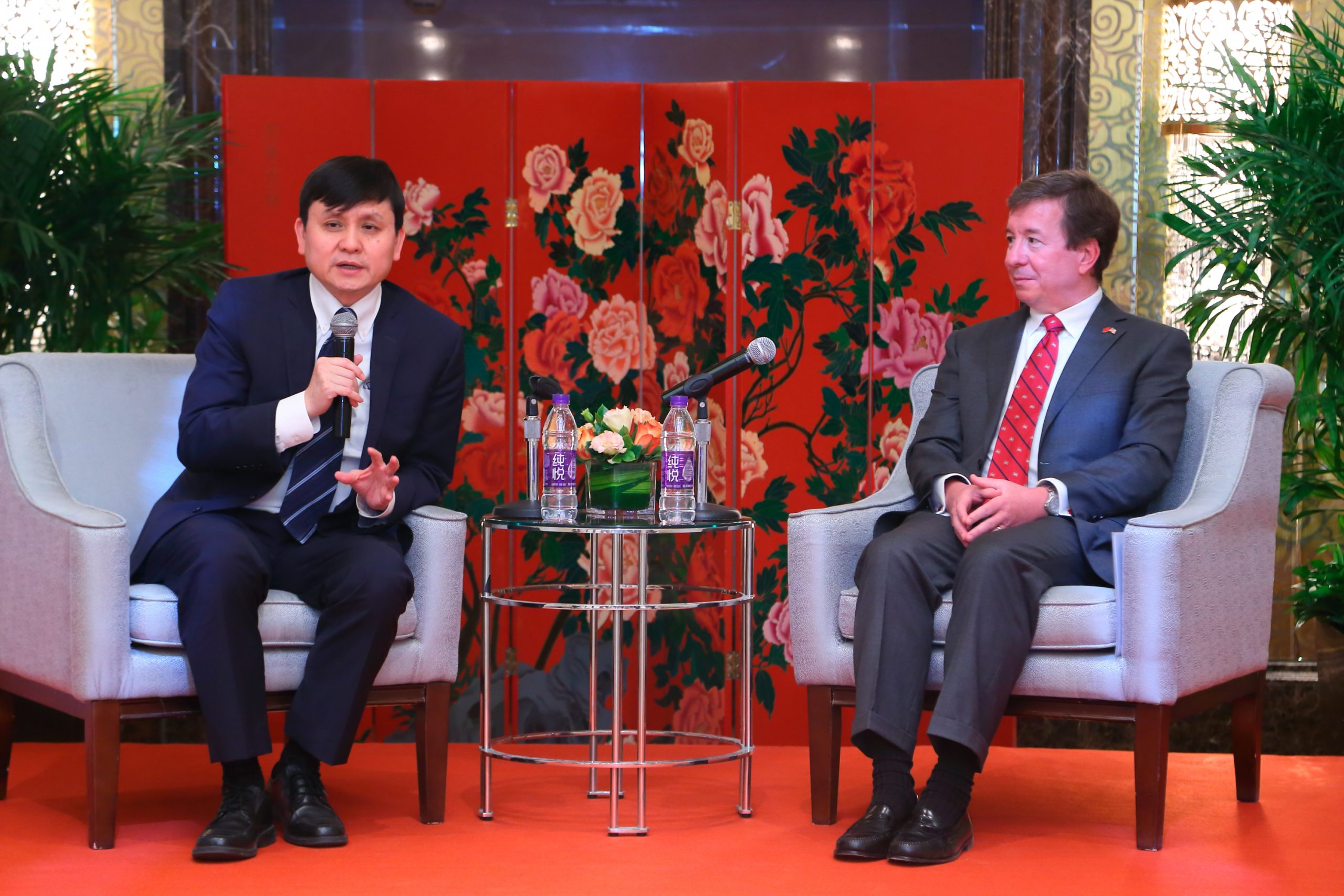Dr. Zhang Wenhong, one of China’s foremost infectious disease experts, has played a critical role in China’s management of COVID-19. Followed by tens of millions of people on Chinese social media platforms, his opinions also wield great influence. Zhang spoke to the AmCham China Quarterly about getting COVID-19 under control, China’s public health system, and his hopes for the future of tackling infectious diseases.
The COVID-19 pandemic has been compared in scale to the devastating 1918 pandemic, considering the high fatality rate and the existence of a huge number of unverified cases. But what is perhaps most different in today’s crisis – more than 100 years later – is the fact that the pandemic is being controlled very differently between countries and across continents. Public health, of course, plays a very important role in the prevention and control of the disease. But there are three areas where those differences become most apparent: the determination of a country’s government; the effectiveness in communication between the government and the public; and the country’s basic public health capacity. One man who has been intimately involved in China’s healthcare response to the virus is Dr. Zhang Wenhong, and says China has been doing exactly the right thing in each of these three areas. “The public has always attached great importance to epidemic prevention. In our culture, we are accustomed to sacrificing our personal interests for the collective interest,” says Zhang. “As a result, during the worst of COVID-19, we have been wearing masks, complying with social distancing rules, and isolating ourselves at home.” But Zhang concedes that China “still cannot completely avoid the emergence of some sporadic cases,” and several Chinese cities have logged a handful of cases in recent months. However, these outbreaks were met with swift control, as the overall public health capacity in China has greatly improved this year. That said, it is not just China with fewer and fewer COVID-19 cases: in fact, many countries have recovered relatively well, such as Singapore and Japan.
Healthcare in China – and the World
“Adequate healthcare resources will contribute to a higher survival rate of COVID-19,” argues Zhang. “With adequate resources, the fatality rate could be reduced to around 1.5%.” China has a vast store of medical resources like PPE, and has a relatively efficient healthcare system. People don’t pay for individual COVID-19 treatment in China; rather, it is covered by public health insurance. China’s early control of COVID-19 proved very cost-effective. Several countries in Europe suffered high fatality rates mainly because of inadequate medical resource distribution. With adequate medical resources, Zhang adds that the fatality rate could be maintained at a level of 0.5%-0.7%. If the elderly populations are protected well, the fatality rate could be less than 0.7%, or about 3-4 times that of a typical flu. Zhang explains that people in the US were only admitted into hospitals once they were in emergency condition, and people without health insurance have had to pay for their treatment bills themselves. “China’s performance in battling COVID-19 is among the best in the world,” he says. “However, this does not mean that the high expenditure of health services and accessibility issues have been solved.”
Cultural Differences
In one recent US-based survey, the willingness of respondents to get a COVID-19 vaccine was around 50%, showing cultural differences between ethnicities, with the willingness of those in Asian countries typically much higher. Most developed nations are aiming to provide vaccines to their high-risk populations in the first half of 2021 in order to reduce the hospitalization rate, therefore reducing the fatality rate. In China, vaccine promotion will be evident in schools and social distancing will still be maintained in public places. “The virus cycle for spread, contact, and reproduction is two weeks,” explains Zhang. “There have only been two examples where viruses like this have disappeared. One was SARS, which had a high morbidity rate. The other was H7N9, which had unsuccessful cross-species transmission. Humans are the biggest source of infection with regard to COVID-19. When the fatality rate is reduced to 0.5%, the whole world could be reopened.” A vaccine is quite important to China considering that medical resources need to be distributed to a population of 1.4 billion people. “There is no need to worry about the safety of the vaccines at this stage. However, post-market research of the vaccination will be needed. Normally it will take 6-12 months to verify the effectiveness of vaccines,” says Dr. Zhang. “The process of verifying the effectiveness needs to be conducted domestically. For now, interim analysis of the vaccines could help verify their effectiveness to some extent.”
China’s Vaccine Expectations
Zhang declares that, overall, the development of a vaccine has been very promising. “Firstly, the vaccine is coming out quickly, whether in China, the United States, or Europe, and there are more and more countries that are completing clinical trials and collecting preliminary data in order to apply for emergency use authorization.” China has conducted Phase III research in other developing countries, which have different clinical trial situations. Zhang notes that “this cannot be compared directly with developed countries, because developing countries might have higher rates of contact with the general populace after the first dose of vaccines than in developed countries.” China’s four main vaccine producers – Tianjin-based CanSino, Wuhan-based CNBG, Beijing-based Sinovac, and Anhui-based ZFLongkema – along with other producers, will need to compare overseas data with domestic data for further research and verification. “The second reason why we feel more optimistic this time is that the coronavirus mutation is much weaker than that of the flu. Although the virus has mutated, its genetic structure has not actually changed. As a result, the vaccine can maintain its effectiveness,” says Zhang, noting that several new vaccines have already been proven effective. “Although a nucleic acid vaccine has never been released before, both American and European companies have shown positive results. Many Chinese companies attempting to develop this vaccine are working on the final phases of data collection. However, we still need to wait until the official and final data come through until it can be authorized for use.” Zhang explains that “a 70% effectiveness rate is enough for use. The control of the pandemic will rely more on the vaccination coverage of the population, with 60% coverage a bare minimum. A coverage rate of 70-80%, he adds, would be quite safe. The vaccine’s distribution plan is another very important factor to be considered in order to ensure everyone has access to it. Demand for the vaccine will be incredibly high, considering there are nearly eight billion people in the world. There are many requirements for transportation conditions for vaccines shipped from the United States and Europe, which could dramatically hinder the distribution of a vaccine for months to come. “If, during this period of time, we fail to take the correct public health prevention and control measures, COVID-19 will continue to spread,” warns Dr. Zhang. “Therefore, this process requires everyone to not only actively promote getting the vaccine, but also to promote effective virus prevention and control methods. Only by grasping this with both hands can the epidemic be completely controlled.”

International Travel and Events
Zhang points out that 2021 will be more complicated with regard to international travel. “There are many things to consider: immigration policies, the reopening of universities, a willingness to travel, whether people in China or the US want to be vaccinated, and more,” he says. “The normalization of international travel will mainly depend on the communication between countries, the number of international flights, and countries’ quarantine policies. Negotiation is needed. Countries tend to follow the principle of reciprocity. Policy changes won’t happen until vaccinations are rolled out. The earliest time that things might return to normal is the second half of 2021.” “I believe that the first large-scale international event in China will be the Shanghai International Import Expo,” says Dr. Zhang. “There will be a lot of foreigners entering China, and Shanghai has adopted a series of measures at different levels of epidemic prevention for different groups of people.” Zhang explains that more than 1.3 million people participated in the recent China International Import Expo (CIIE) this past fall, adding that the overall prevention and control strategy was relatively strict, and the exhibition went off without a hitch. As the world gradually reopens, the next important international event is the Olympic Games in Japan in August 2021. “I believe that the Tokyo Olympic Committee will promote strict social distancing and isolation measures. Olympic athletes entering Japan will not be able to quarantine at the same time,” says Zhang. This requires that the competition area be turned into a closed bubble, ensuring that athletes return to the Olympic Village immediately after they compete. “Japan also needs to ensure that each person downloads an app that maps their movement, similar to China’s Health Kit (健康报 jiankang bao),” notes Zhang. “While this tool cannot completely prevent the spread of the virus, it can greatly reduce the speed that it spreads.” Meanwhile, China’s tourism market in 2020 has been in constant flux as a result of the need to adapt to changes brought on by COVID-19. The biggest constraint for tourism, Zhang argues, is that the industry is subject to vaccine distribution. “Vaccines must travel before people travel,” he says. “If the overall number of new coronavirus cases continues to grow, travel will not be realistic. One challenge that we may run into is the vaccine verification system that different countries adopt. Will the approval of vaccines from different countries be the same? Will proof of vaccine certificates be valid in some countries but not in others? On the whole, this will be a very slow process, but I believe that next year will be a great test of how countries around the world organize their public health systems.”
Recovery, Growth, and Disease Prevention
“On the whole, I think the global impact of this epidemic is very significant, especially on industries that rely heavily on retail and business transactions,” says Dr. Zhang. “On the other hand, e-commerce companies or companies engaged in epidemic prevention may perform slightly better. Umbrellas sell better when it rains. But if the weather is good, no one buys an umbrella. Therefore, the world maintains a certain balance, but, generally speaking, if the lack of interaction between countries continues for a longer period of time, the global economy will take a significant hit.” Zhang also explains how everyone’s energy in China this year was mainly focused on the prevention and control of COVID-19. “When dealing with other diseases, public health centers continued to face many challenges. However, the development of COVID-19 has also had a positive impact on China. Firstly, China’s public health capacity has developed immensely since the start of the epidemic,” he says. “Secondly, society’s attention to public health has increased substantially. Thirdly, China has accumulated a lot of experience in the prevention and control of epidemics. Further down the line, China may invest more resources and energy into public health, using the experience gained from COVID-19 prevention for other infectious diseases. If this is done, I believe there will be incredible progress in the prevention and control of tuberculosis, AIDS, or hepatitis in China.” To Zhang, it’s clear that disadvantaged communities around the world are most at risk, not just during the current pandemic, but for all infectious diseases. He calls on “all sectors of society” to play their respective roles and work together to support these groups, which tend to see a particularly high rate of infectious diseases. “At some point, we will have COVID-19 under control, but controlling all infectious disease among the disadvantaged should become the main focus for 2021 and beyond.”
This article is the cover story for the 2020 AmCham China Quarterly Magazine Issue 4 (to be released).


